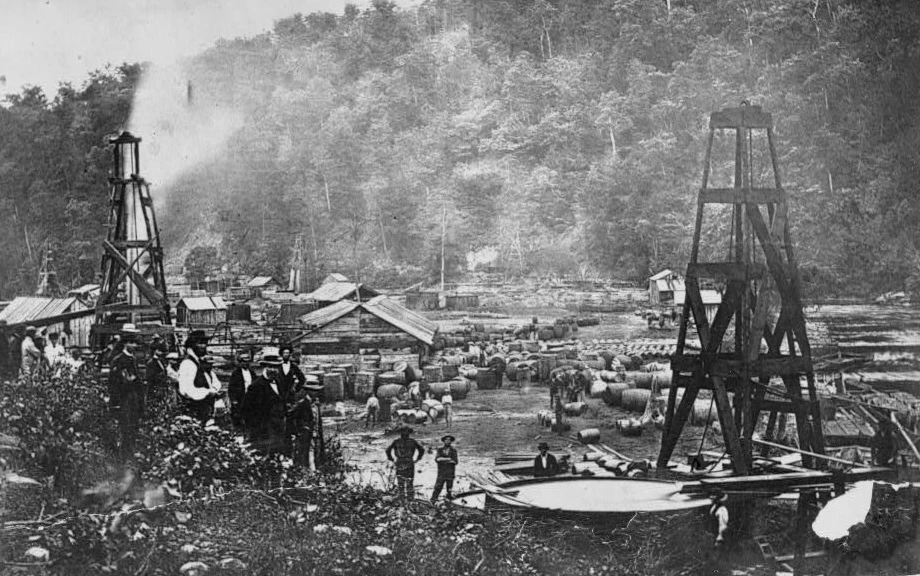Petroleum and Its Products
The St. Albans Weekly Messenger, January 15, 1863
For nearly one hundred and fifty years, the petroleum or oil wells have been known and their produce used for medical purposes. When the French ascended the Allegheny in canoes in 1715, the Indians showed them an oil spring at the place now known as Oil Creek, in Venango County, Pennsylvania. The natives used the petroleum as a liniment for inflammatory rheumatism.

It was long known by the name of “Seneca Oil,” and prescribed for rheumatic diseases. According to Wachtiar, the Indians had used this natural oil for many hundred years. Their oil wells, sunk in the gravel and clay of the bottom lands in the Allegheny and its branches, are visible by hundreds to this day. But it is only within the last eight or nine years that anything was extensively done to realize the great value of those oleaginous deposits.
The Cincinnati Gazette gives the following history of the rise and progress of the petroleum trade:

“In 1854, Mr. Drake of Titusville, at the Forks of Oil Creek, conceived the plan of getting a better yield from the springs. He bored an artesian well, and at the depth of 70 feet had the luck to strike a fissure or vein that sent up a large flow of oil. Professor Silliman examined some of it and concluded that it could be distilled and a good illuminating oil extracted from it.
Artificial coal tar had been already produced from bituminous coal, from which burning oil is easily made. But natural petroleum, or stone oil, is generally richer in the inflammable materials and more easily distilled.
Thus the ‘coal oil’ excitement commenced. From 1860 to this time it has taken the lead of all other excitements in America. Mr. Drake put in a tube and a pump, as the salt makers do, and obtained an average of eight and ten barrels per day. Some days he had twenty barrels, which yielded 75 to 80 percent of refined oil, then worth $1.50 per gallon. McClintock’s well, at the old spring, yielded eight barrels of forty gallons a day for a month together, for which he received 75 cents per gallon.
At the close of 1861, the narrow valley of Oil Creek, less than half a mile wide, presented the appearance of a continuous slab city, from its mouth to Titusville, a distance of eighteen miles by the stream. The limited space between the hills was crowded with board shanties, derricks, sheds for steam engines, blacksmith shops, and stables for horses.
In the year 1860 there were produced 25,000 barrels on Oil Creek. There were then 246 wells, producing 435 barrels per day, but only 20 of them were profitable. On the Allegheny River there were seventeen wells, which yielded 314 barrels a day. There were also 567 wells that did not pump, on account of the great fall in price, and a falling off in the yield of oil.

In 1861, by extending the depth of the wells to 400 and 450 feet, still greater wonders were brought to light. Seventy-five wells flowed spontaneously, some of them at a rate that could not be controlled.
As soon as the first paroxysm was past, tubing was introduced, with stop-cocks and vats provided to receive the oil. In one instance, a well discharged three thousand barrels in twenty-four hours. Another discharged twenty-five hundred. Others ranged from one to seven hundred barrels a day. This copious flow put a stop to the working of the pumping wells, of which there are reported to be Venango and Crawford counties two thousand. At a shilling a gallon, a pumping well does not pay unless it yields five barrels per day.
For several months the daily yield of the flowing wells was five thousand seven hundred and seventeen barrels. Sixty-two of the flowing wells were not discharging at the same time with the seventy-five wells above spoken of. At the present time the daily discharge is about 5,000 barrels. The price of crude oil four months since was as low as one dollar per barrel. It is now $6 to $6.50, including the package. This stimulates the pumping wells into operation again. They can add to the product 2,500 barrels a day.
It is next to impossible to state the total yield of the Oil Creek region. At the close of 1861 it is given by Oil City Register as amounting to 1,902,000 barrels. In January 1862, 80,000 barrels were carried away by the several Northern routes; and in October 1862, 30,000 barrels; 9,000 remaining in store. For the week ending Nov. 27, 1862, the Register gives the regular shipments by the Allegheny River south as 9,351 barrels, and during a recent rise, 75,000.
In 1861, there were twenty-five refineries in Venango county. There are now fifty-three, and in the oil region probably eighty, with a capacity of 8,000 barrels per week, refined oil. Several of these works are owned in Europe, where products are carried.”
